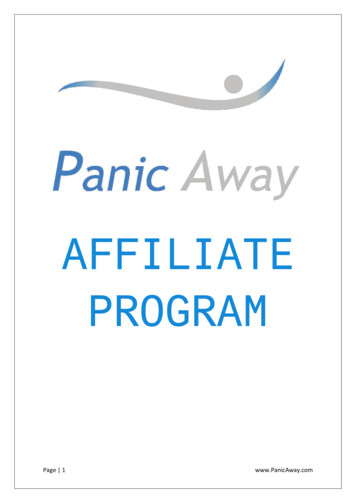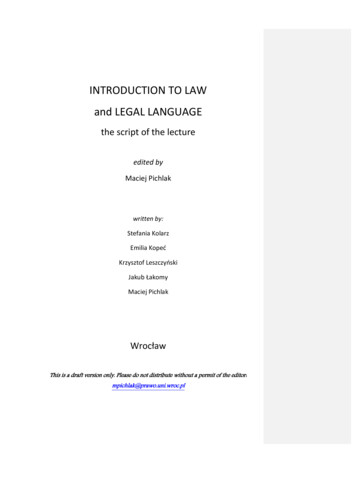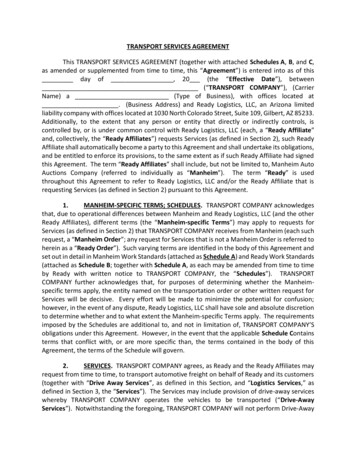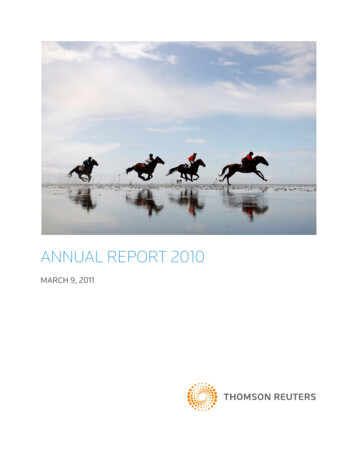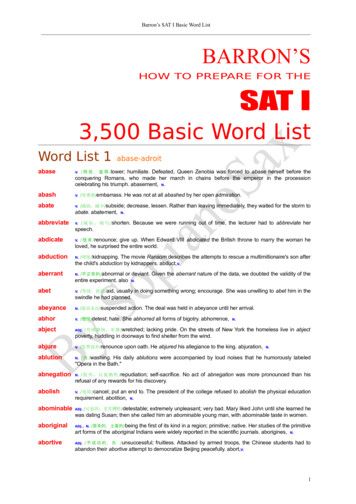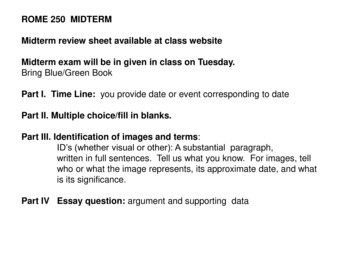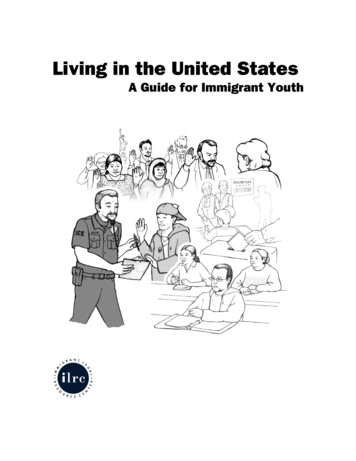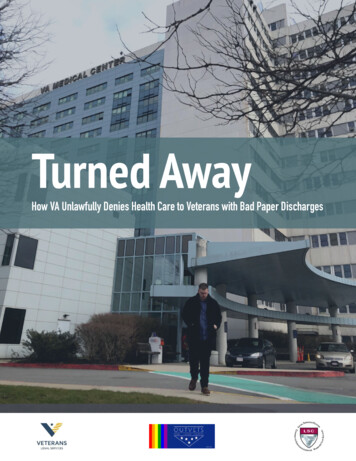
Transcription
Turned AwayHow VA Unlawfully Denies Health Care to Veterans with Bad Paper Discharges
ACKNOWLEDGEMENTSThis report was prepared by the Veterans Legal Clinic at the Legal Services Center ofHarvard Law School, Veterans Legal Services, and Wilmer, Cutler, Pickering, Hale and DorrLLP on behalf of OUTVETS. Our deepest gratitude to the many veterans who shared theirexperiences attempting to access VA health care and to all the veterans still fighting to getthe support and recognition that they deserve. Thanks to the veterans advocates across thecountry who contributed to this report and who work tirelessly to ensure that all veteransreceive the care and support that they deserve. Special thanks to Disabled AmericanVeterans, TripAdvisor, Connecticut Veterans Legal Center, and Swords to Plowshares fortheir substantial contributions and guidance, and to Emily Brignone, Thomas Burke, KrisGoldsmith, James Ridgway, and Ali Tayyeb for their review and input.Legal DisclaimerThis report is neither a solicitation nor an offer to represent any individual concerning any legal problem. Thisreport is not meant to constitute legal advice or legal services, not is it intended to serve as a substitute forconsulting with a lawyer. Individuals who have been denied access to veterans health care or other benefits areencouraged to consult with an attorney or non-attorney advocate. 2020 OUTVETS, Legal Services Center of Harvard Law School, and Veterans Legal Services
TABLE OF CONTENTSI. Executive Summary 1II. Background 3A. What is “Bad Paper”? 3B. Why Do Servicemembers Get “Bad Paper”? 4C. How Many Veterans Have a Bad Paper Discharge? 7D. The Myth of the Easy Discharge Upgrade 8III. The Problem 10A. The Importance of VA Access 10B. VA Obligations to Applicants 10C. VA Eligibility Standards 11IV. Methodology 12V. Findings and analysis 13A. VHA Facilities Across the Country Deny Veterans Health Care Without Due Process orProper Adjudication 13B. VHA Staff Receive Incorrect or Inadequate Training and Guidance 17C. VA’s Turn-Away Problem Likely Disproportionately Impacts Veteran SubpopulationsIncluding Navy and Marine Corps Veterans, Post-9/11 Veterans, Enlisted Veterans, andVeterans with PTSD or Other Service-Related Mental Health Conditions 22VI. Recommendations and conclusions 25A. VA Must Improve its Training, Guidance & Oversight 26B. VA Must Improve Communication Between VHA & VBA and BetweenVA & Veterans 28C. VA Must Remedy Past Unlawful Turn-Aways by Conducting Outreach andRemediation Efforts 30VII. Appendix 33VIII. Endnotes 46
I. EXECUTIVE SUMMARYMarine Corps veteran Dwayne Smith survived a deployment to Afghanistan, but almost didnot make it through his transition back to civilian life when he returned stateside. Dwaynereturned home with both Post-Traumatic Stress Disorder (PTSD) and a Traumatic Brain Injury(TBI)—the signature wounds of the wars in Iraq and Afghanistan. Yet, when Dwayne went tothe Department of Veterans Affairs (VA) to get health care for his military injuries, VA turnedhim away. Why? Because when VA frontline staff looked at Dwayne’s discharge papers andsaw that he had an Other Than Honorable discharge, they decided he would not get anyVA care. Dwayne, who received his discharge after self-medicating to cope with PTSD andleaving his post when a family member was diagnosed with cancer, went on to seek help atmultiple VA health care facilities. But each time, VA turned Dwayne away, in violation of thelaw. The law required that VA staff help Dwayne apply for health care and ensure that hisapplication was properly reviewed and a written eligibility decision issued, including noticeof appeal rights. It took more than five years and the assistance of a pro bono lawyer beforeDwayne could apply and finally be approved for VA health care and benefits. Tragically,Dwayne is not alone—veterans with bad paper discharges get turned away by VA frontlinestaff every day without being allowed to apply for care.Imagine trying to make an appointment with your doctor when you are sick, or yourtherapist when you are facing a mental health crisis, and the front desk staff tells you thatthey personally decided you cannot do so. For decades, that is what has happened to manythousands of former servicemembers with bad paper discharges when they attempted toseek care from VA. Importantly, an estimated 400,000 are currently at risk of being turnedaway from services they may be entitled to. Many frontline staff at VA health care facilitieshave improperly turned away former servicemembers seeking health care, telling them thatthey are ineligible due to their military discharge statuses—without even allowing them toapply. This is not just unfair, it is unlawful. VA must take immediate action to prevent thisinjustice from happening and to remedy past harms to servicemembers like Dwayne whowent five years without the care he needed and deserved because VA failed to follow itsown procedures.Why are stories like Dwayne’s so common? Every servicemember is assigned a “characterof service” or “discharge status” upon leaving military service. While most servicemembersreceive Honorable discharge statuses, a substantial percentage—approximately 7 percent ofveterans discharged since 1980—receive discharge statuses that are not Honorable, whichare known as “bad paper.” Servicemembers usually get “bad paper” because of somealleged misconduct, though that misconduct frequently is minor, for a military-only offense,or not proved in any court. Studies also show that many servicemembers are separated withbad paper for misconduct related to a service-related mental or physical health condition orMilitary Sexual Trauma (MST).Veterans with bad paper have higher rates of mental health conditions, suicide,homelessness, and unemployment.1 Many have disabilities related to their service, whichmay in fact have led to their being discharged with bad paper. Many were discharged withbad paper under past discriminatory practices that targeted veterans because of their sexual1Turned Away
orientation or sexual identity. Veterans with bad paper therefore are some of the veteransmost in need of VA’s health care services—yet they are being wrongfully excluded fromthose services without due process.A bad paper discharge affects whether and to what extent a former servicemember maybe eligible for federal veterans benefits. For most benefits administered by VA, includinghealth care, a bad paper discharge does not render a veteran categorically ineligible.Rather, it puts them in a “limbo” category that requires VA to conduct an individualizedeligibility determination to decide whether the veteran was discharged under “dishonorableconditions” or “other than dishonorable conditions.” That determination process is itselfbeset by delays and inconsistent decisions.But many veterans with bad paper report attempting to apply to VA for health care andsimply being turned away. They are told by VA frontline staff that their discharge statusmakes them categorically ineligible for health care. Further, sometimes they are told toapply to the Department of Defense (DOD) to upgrade their discharge status, and toreturn to VA later if the discharge upgrade is successful. That DOD process typically isburdensome, is rarely successful, and takes years to resolve.Every veteran—regardless of discharge status—has the right to apply to VA for healthcare. Every veteran has the right to receive a written decision on his or her application andinformation on how to appeal any denial.Many veterans with bad paper are eligible for VA health care but are being wrongfullyturned away. While there should be consequences for military misconduct, those consequences should not include being denied health care—especially if you have a service-related disability, are experiencing homelessness, or are dealing with the impact of MST, as somany veterans with bad paper are.This report provides background information about why veterans get “bad paper”and about VA’s health care eligibility standards and then documents, including throughgovernment data collected through Freedom of Information Act requests, how VA has beenimproperly turning away veterans with bad paper from receiving VA health care. The reportconcludes with recommendations about the steps VA must take to ensure that every veteranis afforded the right to apply for health care and to guarantee that no veteran is wronglydenied the care that the veteran needs and deserves.The extensive research and investigation underlying this report, prepared on behalf of theveteran service organization OUTVETS, documents that the vast majority of veterans withbad paper are not currently enrolled in VA health care—many of them because they havebeen wrongly told by VA to just go away. For many veterans, this initial rejection leads themto end their search for care altogether. It is time for VA to stop this cycle of misinformationand stigma and to honor that every person who has served in the military has a right toapply for VA care.Turned Away2
II. BACKGROUNDA. What is “Bad Paper”?Upon separation from military service, every servicemember is assigned a “character ofservice.” The character of service is set forth on the Department of Defense Form 214 (“DD214”), sometimes referred to as discharge papers, which is issued to every servicememberas the servicemember leaves the military and enters civilian life. The military currently usesthe following designations for a servicemember’s character of service: Honorable, UnderHonorable Conditions (General), Other Than Honorable, Bad Conduct, or Dishonorable.*Honorable, General, and Other Than Honorable characters of service are “administrative”discharges, meaning that the servicemember’s military command effectuated the dischargeadministratively and without a court-martial. This usually means the servicemember didnot have the benefit of a court hearing to determine whether the discharge status wasappropriate. Bad Conduct and Dishonorable discharges are “punitive” discharges becauseonly a military court-martial can impose such status as punishment for a criminal conviction.A Bad Conduct discharge may be imposed through a special court-martial or a generalcourt-martial; a Dishonorable discharge may be imposed only through a general courtmartial. There are also some discharges that do not characterize an individual’s service andare therefore known as Uncharacterized discharges. These include Entry Level Separationand Void Enlistment.An Honorable discharge is the only type of discharge that carries no stigma and imposes noimpediments to the former servicemember’s ability to access veterans benefits, supports,and services.2 The other characters of service—namely General, Other Than Honorable,Bad Conduct, and Dishonorable discharges—are stigmatizing to various degrees and cancreate substantial barriers to the former servicemember’s ability to access veterans benefits,supports, and services. Discharges such as these are known as “bad paper” discharges,because the harmful character of service is listed on each separating servicemember’s DD214.†As a note on terminology, there are many different definitions of who is a “veteran” understate and federal law or used by various veterans organizations. Many require that a formerservicemember have a specific discharge status, usually Honorable or at least underhonorable conditions. VA’s definition, as set forth in statute and regulation and describedin detail below, requires that the discharge be under “other than dishonorable” conditions,which does include some former servicemembers with bad paper discharges.3 For purposesof this report, we will use an inclusive definition of the term “veteran” that encompassesany person who has served at least one day of active duty military service, without regard totheir discharge status.* In place of a Dishonorable discharge, officers are given a Dismissal. OTH used to be known as Undesirable.† Note that a “bad paper” discharge is not synonymous with a Bad Conduct Discharge (BCD). “Bad paper”refers to discharges that are not honorable, and for purposes of this report, specifically includes Other ThanHonorable (formerly Undesirable), Bad Conduct, and Dishonorable discharges. The vast majority of veteranswith bad paper—more than 80 percent of such veterans discharged since 1980—have administrative OtherThan Honorable discharges.3Turned Away
Similarly, the term “bad paper” has multiple definitions. Some include all veterans withless-than-fully-Honorable discharges, and some include veterans with Honorable dischargeswho have stigmatizing information on their DD 214s or military records. For purposes ofthis report, the term “bad paper” includes only those veterans with Other Than Honorable,Bad Conduct, and Dishonorable discharge characterizations, the large majority of whom areveterans with administrative Other Than Honorable discharges.B.Why Do Servicemembers Get “Bad Paper”?No single reason explains why servicemembersdo not receive a fully Honorable discharge.Some servicemembers exercise poorjudgment and engage in misconductwithout any mitigating circumstances. Otherservicemembers, however, receive bad paperunjustly. Some had undiagnosed physical ormental health disabilities that contributed tobehavior that was interpreted as unmitigatedmisconduct. Others may have been dischargedwith bad paper based on discriminatory policies,such as the now-repealed Don’t Ask, Don’t Tell (DADT) policy. Commanding officers attimes are under pressure to be mission capable and ready, or to prepare for a deployment,leading to bad paper separations for servicemembers dealing with stresses or trauma, sothat a new servicemember can replace them.4Moreover, because the character of service assigned at discharge is determined byeach servicemember’s chain of command, the issuance of bad paper can be arbitrary orinfluenced by personal philosophy or prejudice. So, too, are there disparities among themilitary branches in the frequency withwhich they issue bad paper and thereasons for which they do so. In short, ahost of intersecting factors contribute tobad paper discharges, some of which arediscussed in more detail below.a. Post-Traumatic StressDisorder & Traumatic BrainInjuryMany servicemembers receive bad paperdue to behavior that stems from anundiagnosed mental health or physicalcondition, or the experience of trauma,or both. One recent study found that16% of the servicemembers separated formisconduct from fiscal year 2011 through2015 had been diagnosed with PostTurned Away4
Traumatic Stress Disorder (PTSD) or Traumatic Brain Injury (TBI) during the two years prior toseparation5, and many more servicemembers likely had PTSD or TBI but went undiagnosedor were misdiagnosed. PTSD and TBI are considered the signature wounds of the Iraqand Afghanistan conflicts and both conditions can significantly impair a person’s ability toconform their behavior to the military’s standards. In particular, the symptoms of PTSD canlead to behaviors that are misinterpreted by military commanders, which in turn can lead toa bad paper discharge.Servicemembers, especially servicemembers who deploy to combat zones or whoexperience Military Sexual Trauma (MST), are at higher risk for PTSD.6 Among the commonsymptoms of PTSD are sleep disorders, mood changes, reckless behavior, substance use,and isolation.7 These same symptoms can contribute to behavior—such as failure to carryout duties, being chronically late, or not complying with policies—deemed inconsistentwith the standards of military service.8 Especially when a servicemember’s PTSD isundiagnosed, a military command may discharge a servicemember with bad paper withoutany understanding of the true origin of the servicemember’s conduct and without anyconsideration of the mitigating circumstances.9This same troubling dynamic can occur for servicemembers who suffer from TraumaticBrain Injury (TBI). Just as military service can exposeindividuals to higher risks for PTSD, military servicealso poses higher risks for experiencing a TBI.10 In asimilar manner to football players experiencing theconsequences of chronic concussions that may notinitially be evident, even with advances in science andmedical care, the military has failed to diagnose TBI insubstantial numbers of servicemembers who served inthe Iraq and Afghanistan conflicts.11 Indeed, the militaryhas long struggled to understand, diagnose, andproperly treat what is now known as TBI and related conditions.12TBI can produce symptoms similar to PTSD. TBI is associated with other symptoms as well,including difficulty remembering, concentrating and making decisions, slowness in thinking,speaking, and acting, and fatigue.13 As in the case of PTSD, the symptoms of TBI cancontribute to behaviors that military commanders deem to be misconduct and can promptmilitary commanders to discharge a servicemember with bad paper.14 For example, from2009 to 2015, the Army discharged with bad paper 22,000 soldiers who had deployed andbeen diagnosed with PTSD or TBI.15b. Don’t Ask, Don’t Tell & Prior Policies Affecting LGBTQ ServicemembersThe military has a long history of discriminating against servicemembers who either were orwere perceived to be Lesbian, Gay, Bisexual, Transgender, or Queer (LGBTQ). That history ofdiscrimination included the Don’t Ask, Don’t Tell (DADT) policy in place from 1994 to 2011,as well as predecessor policies that were even more harsh, and extends to the current banon service by openly transgender individuals. Under DADT and prior policies, between theend of World War II and the repeal of DADT, over 100,000 servicemembers were discharged5Turned Away
with bad paper because of their actual or perceived LGBTQ status. In addition, thousandsof LGBTQ servicemembers were discharged with bad paper for behaviors—interpreted asinexcusable misconduct—that stemmed from the trauma of having to conceal their sexual orgender identity or were discharged for pretextual reasons, such as minor misconduct, whenthe true cause was discrimination against them due to their LGBTQ status.16 The nation’shistory of discrimination against LGBTQ servicemembers is therefore another cause of badpaper discharges that is perpetuated when these veterans are turned away from VA withoutbeing allowed to apply.c. Arbitrary & Disparate Imposition of Bad Paper DischargesIndividual military commands possess wide discretion to decide what conduct justifiesa bad paper discharge. This is especially true with respect to the Other Than Honorabledischarge, which is an administrative discharge that can be imposed by a commandrelatively swiftly, without substantial oversight, and with minimal procedural protectionsfor the servicemember. The same conduct is often not treated consistently across militarycommands, resulting in disparate treatment of similarly situated servicemembers. Behaviorthat one chain of command may decide should lead to a servicemember’s discharge withbad paper, may not lead to any discharge—let alone a discharge with bad paper—underanother command’s oversight, even though the conduct of the servicemembers is essentiallyidentical. Moreover, investigations have repeatedly found racial disparities in the impositionof military punishment and bad paper discharges.17 A 2017 study by Protect our Defendersshowed that from 2006 to 2015, black soldiers were 61% more likely to face a general orspecial court-martial than white soldiers.18This disparity was confirmed by the Government Accountability Office, which found thatservicemembers with similar service histories but in different service branches often receivedwidely different discharge characterizations.19 For the same misconduct, one might get anHonorable discharge, another a General discharge, and a third an Other Than Honorabledischarge, merely because of their branch’s and command’s leadership culture. While eachbranch of service has its own mission and philosophy, whether a person chose to serve inthe Army or the Navy, the Air Force or the Marine Corps should not affect whether thatperson can access health care after discharge.The disparities caused by such arbitrariness have been compounded in at least two ways.First, the military has increasingly used administrative discharges to issue bad paper toservicemembers. Since World War II, the percentage of servicemembers who receive anOther Than Honorable discharge has increased by a factor of five.20 Second, wide variationexists across the service branches in the percentage of servicemembers who receive OtherThan Honorable discharges. The chart below demonstrates this wide variation over a 36year period. For example, although the Marine Corps is by far the smallest service branchin terms of active duty personnel, it has by a wide margin accounted for at least 40% ofthe military’s Other Than Honorable discharges issued each fiscal year from 2010 to 2015.Meanwhile, the Air Force has generally accounted for well under 5% of the military’s Otherthan Honorable discharges issued during that same period.Turned Away6
Source: Department of Defense FOIA Response.PERCENT ENLISTED SERVICEMEMBERS WITHB A D PA P E R D I S C H A R G E 9%0.2%1.9%1.0%1.4%0.7%0World War II2.5%0.4%Korean WarPunitiveVietnam WarOth er than Honorable1.0%0.9%Cold WarFirst Gulf War1.0%Post-9/11General (Under Honorable Conditions)Source: Department of Defense FOIA response; Veterans Legal Clinic, Underserved (2016).The increased use of administrative discharges and the disparate rates of bad paperdischarges among the branches of service likely have complex origins. These trends may bedriven, at least in part, by the transition from a conscription to an all-volunteer force, otherchanges in the overall size and structure of the military, and, of course, the unique cultureand disciplinary philosophies of each branch of service.21C. How Many Veterans Have a Bad Paper Discharge?Since 1980, more than 575,000 servicemembers have received an Other Than Honorable,Bad Conduct, or Dishonorable discharge—what this report calls a “bad paper” discharge—representing about 7% of those with characterized discharges. The vast majority—81%—7Turned Away
of those bad paper discharges are administrative Other Than Honorable discharges, notpunitive discharges by court-martial, meaning these veterans never received a court processto determine whether the discharge characterization was appropriate, even though thatcharacterization can carry a lifetime of consequences.Additionally, more than 600,000 servicemembers since 1980 have received Generaldischarge characterizations. While such discharges do not preclude access to most VAbenefits, such as disability compensation and health care, they do impose a stigma, baraccess to some benefits, and impede employment prospects.‡D. The Myth of the Easy Discharge UpgradeA common myth in the military community is that a bad paper discharge can be easilychanged once a servicemember joins the civilian world. This myth may account for whysome servicemembers are willing to accept an Other Than Honorable discharge duringthe administrative separation process. It is true that the branches of service operateadministrative boards—known as discharge review boards and boards for correction ofmilitary or naval records—and that these boards have the legal authority to upgrade adischarge that was previously imposed by the military. For example, these administrativeboards have the authority to change the character of service on a veteran’s DD 214 fromOther Than Honorable to Honorable and to correct other errors or injustices. However, itis inaccurate to say that the discharge review boards and boards for correction of recordsdispense such relief frequently or promptly.Historically, the percentage rate of successbefore the boards is extremely low—in thesingle digits—with lower success rates for selfrepresented veterans, who make up the vastmajority of petitioners to the boards due to alack of free or affordable legal help. Althoughcertain categories of petitioners, such as thosewho establish that they had unrecognized PTSDor TBI that contributed to the misconduct leadingto discharge, have had higher rates of success in recent years, the odds of success remainlow.22 Paradoxically, the veteran may also need access to VA to establish a PTSD or TBIdiagnosis.Petitioners can expect lengthy waits to receive a decision from these boards. The dischargereview boards typically take 12 to 24 months to decide cases, and the boards for correctionof records typically take 18 months to decide cases, though it frequently can take longer.In sum, receiving a discharge upgrade is hardly certain or swift. Nor does the potentialavailability of a discharge upgrade excuse VA’s unlawful exclusion of eligible veterans fromaccess to healthcare or compensate the veterans for the adverse health effects and financialexpenses suffered while awaiting a discharge upgrade decision, as discussed below.‡ For example, access to Post-9/11 G.I. Bill education benefits may require a fully Honorable discharge,depending on the particular circumstances of the veteran’s service and discharge.Turned Away8
Military Review Board Discharge Upgrade Data - FY 10.9%7.5%8.2%10.2%0%ABCMRADRBBCNRDischarge Upgrade GrantedNDRBOth er Relief GrantedAFBCMRAFDRBDeniedSource: Boards of Review Reading Rooms Board Statistics. See Appendix for additional data.Military Review Board Decision Rates for Mental Health-RelatedApplications - FY18Percent of Veterans Granted Discharge DRBSource: Boards of Review Reading Rooms Board Statistics.9Turned Away
III. THE PROBLEMA. The Importance of VA AccessThe Department of Veterans Affairs (VA) was created to be a single, central agency thatcould fulfill our nation’s obligation to provide care and support to our veterans. VA hasthree main components: the Veterans Benefits Administration (VBA), the Veterans HealthAdministration (VHA), and the National Cemetery Administration (NCA). VBA is responsiblefor deciding whether veterans and their survivors and dependents are eligible for benefits,such as service-connected disability compensation, pension, vocational rehabilitation, andhome loans, and for then providing those benefits. VBA also adjudicates whether a veteranwith a bad paper discharge was discharged under “other than dishonorable” conditions, asdiscussed below. VHA manages medical centers and health care facilities across the countryand is responsible for enrolling veterans in VA health care and medical benefits. NCAmaintains federal veteran cemeteries.VA is supposed to be non-adversarial and “veteran friendly.” It was specially designedto meet veterans’ needs, especially those arising out of military service. VA medicalfacilities, for example, offer expert care for medical issues that are more prevalent in theveterans community, such as those associated with amputations, TBI, and PTSD. VA hasdedicated programs to reintegrate servicemembers into the civilian world and to addresshomelessness and suicide risk, which disproportionately affect the veteran population.For veterans with bad paper, access to VA is particularly critical. Studies have shown thatveterans with bad paper are three times more likely to experience suicidal ideation.However, veterans with bad paper who have recently accessed VA mental health services areno more likely than other veterans to experience suicidal ideation.23 Thus being excludedfrom VA mental health care leaves veterans at much higher risk of suicide.For those reasons, ensuringveterans’ access to VA servicesis essential to upholding thenational duty to our veteransand in many cases, they aretruly life-saving. Given that theprimary way that veterans accessVA services is through its healthcare system, VA health care should receive priority attention to make sure that no veteran iswrongly denied access.B.VA Obligations to ApplicantsThe law grants veterans certain rights and mandates that VA provi
Harvard Law School, Veterans Legal Services, and Wilmer, Cutler, Pickering, Hale and Dorr LLP on behalf of OUTVETS. Our deepest gratitude to the many veterans who shared their experiences attempting to access VA health care and to all the veterans still fight
